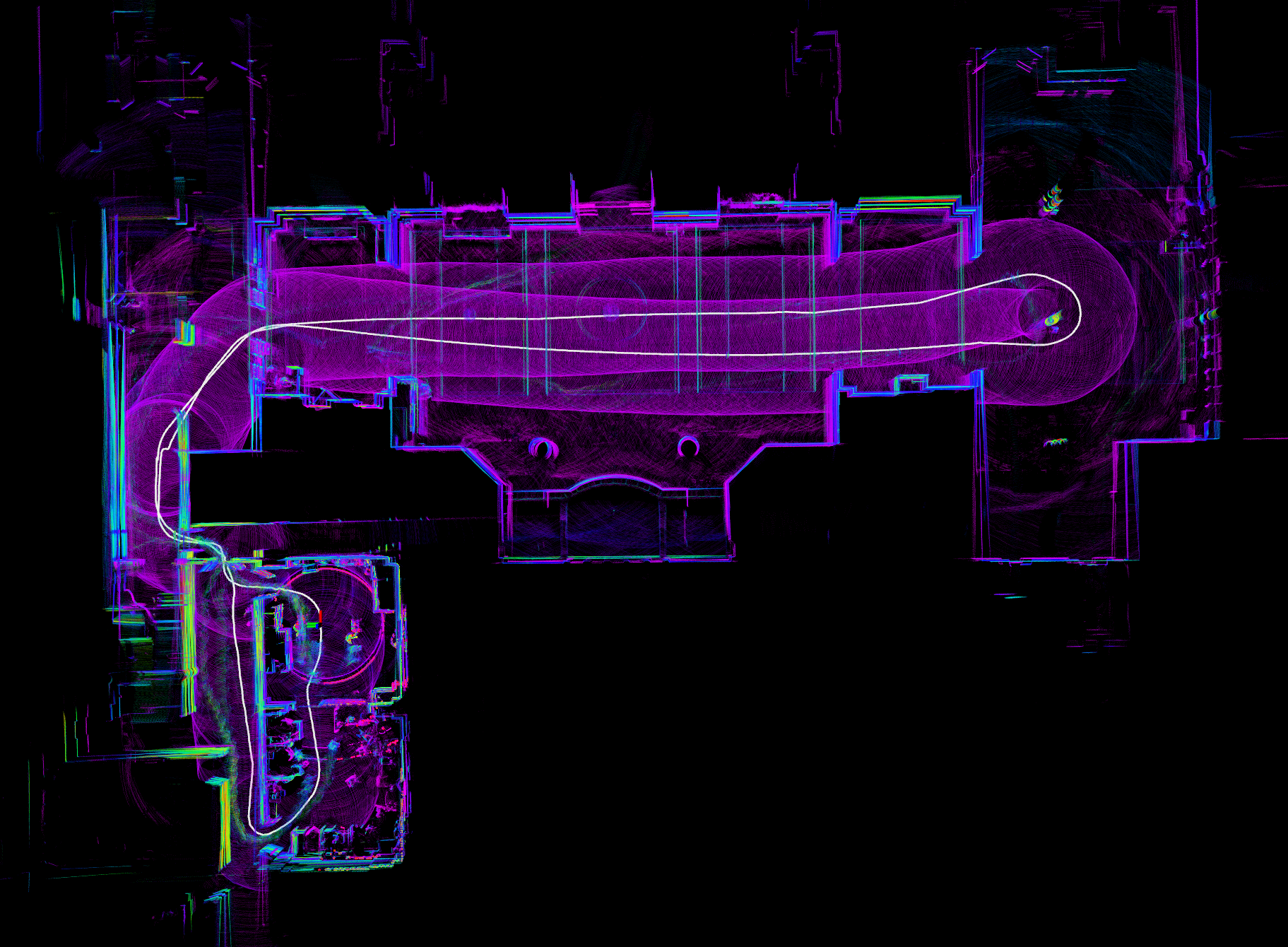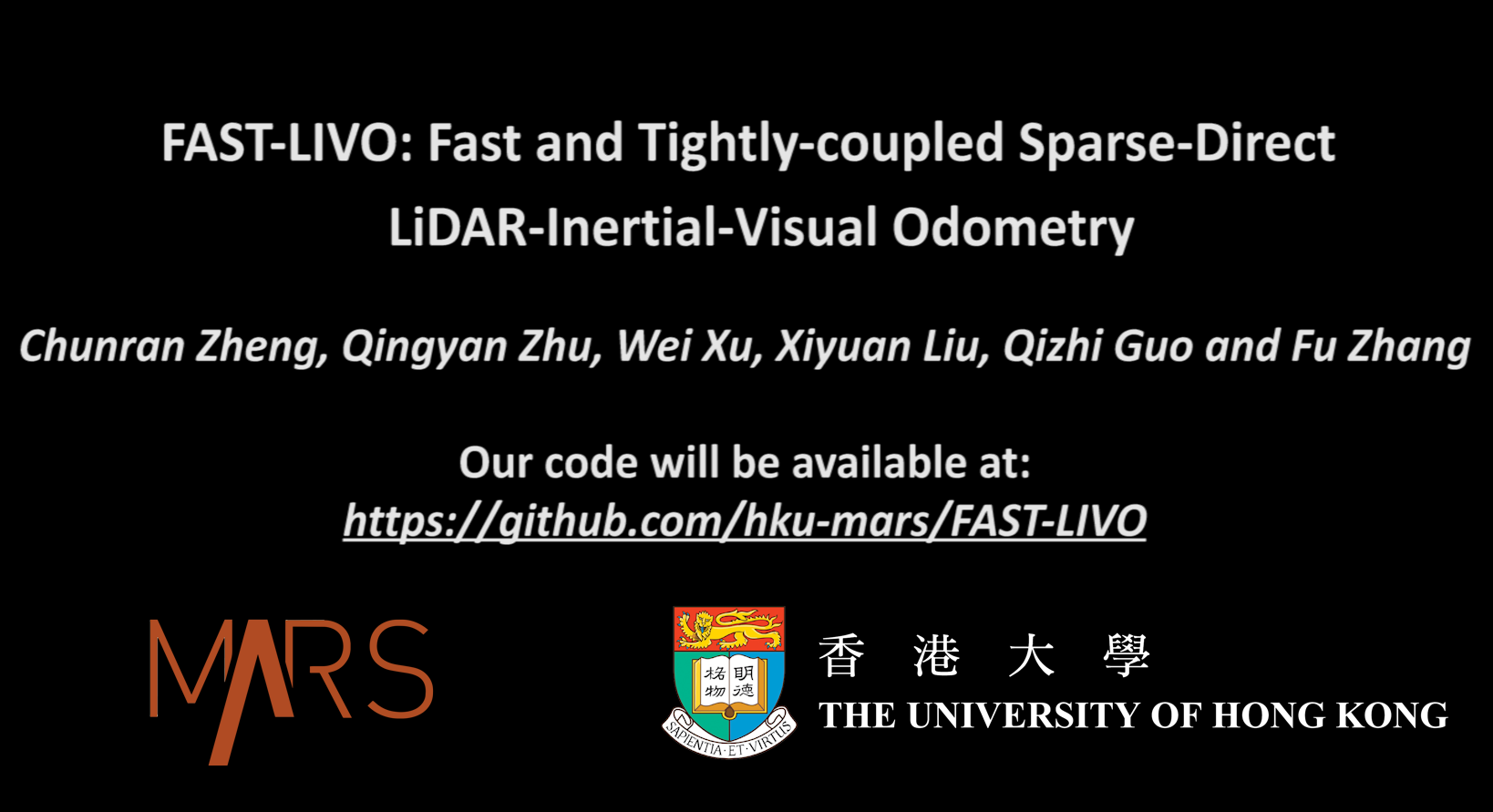-
Modify LiDAR-IMU rotation extrinsic in point cloud undistortion
-
Modify the rotation threshold of add direct visual update
-
Modify the LiDAR feature selection
-
Support velodyne LiDAR
-
Support LIO mode visualization in RViz
-
Support RGB pcd file output
-
NTU-VIRAL dataset (https://ntu-aris.github.io/ntu_viral_dataset/)
-
Newer College dataset (https://ori-drs.github.io/newer-college-dataset/)
-
S3E dataset (https://dl.amovlab.com:30443/s3e/)
-
HKU MARS dataset (https://mars.hku.hk/dataset.html)
- Support GNSS fusion
FAST-LIVO is a fast LiDAR-Inertial-Visual odometry system, which builds on two tightly-coupled and direct odometry subsystems: a VIO subsystem and a LIO subsystem. The LIO subsystem registers raw points (instead of feature points on e.g., edges or planes) of a new scan to an incrementally-built point cloud map. The map points are additionally attached with image patches, which are then used in the VIO subsystem to align a new image by minimizing the direct photometric errors without extracting any visual features (e.g., ORB or FAST corner features).
Contributors: Chunran Zheng 郑纯然, Qingyan Zhu 朱清岩, Wei Xu 徐威
Our paper has been accepted to IROS2022, which is now available on arXiv: FAST-LIVO: Fast and Tightly-coupled Sparse-Direct LiDAR-Inertial-Visual Odometry.
If our code is used in your project, please cite our paper following the bibtex below:
@article{zheng2022fast,
title={FAST-LIVO: Fast and Tightly-coupled Sparse-Direct LiDAR-Inertial-Visual Odometry},
author={Zheng, Chunran and Zhu, Qingyan and Xu, Wei and Liu, Xiyuan and Guo, Qizhi and Zhang, Fu},
journal={arXiv preprint arXiv:2203.00893},
year={2022}
}
Our accompanying videos are now available on YouTube (click below images to open) and Bilibili.
Ubuntu 16.04~20.04. ROS Installation.
PCL>=1.6, Follow PCL Installation.
Eigen>=3.3.4, Follow Eigen Installation.
OpenCV>=3.2, Follow Opencv Installation.
Sophus Installation for the non-templated/double-only version.
git clone https://github.com/strasdat/Sophus.git
cd Sophus
git checkout a621ff
mkdir build && cd build && cmake ..
make
sudo make installVikit contains camera models, some math and interpolation functions that we need. Vikit is a catkin project, therefore, download it into your catkin workspace source folder.
cd catkin_ws/src
git clone https://github.com/uzh-rpg/rpg_vikit.gitFollow livox_ros_driver Installation.
Clone the repository and catkin_make:
cd ~/catkin_ws/src
git clone https://github.com/hku-mars/FAST-LIVO
cd ../
catkin_make
source ~/catkin_ws/devel/setup.bash
Please note that our system can only work in the hard synchronized LiDAR-Inertial-Visual dataset at present due to the unestimated time offset between the camera and IMU. The frame headers of the camera and the LiDAR are at the same physical trigger time.
Edit config/xxx.yaml to set the below parameters:
lid_topic: The topic name of LiDAR data.imu_topic: The topic name of IMU data.img_topic: The topic name of camera data.img_enable: Enbale vio submodule.lidar_enable: Enbale lio submodule.point_filter_num: The sampling interval for a new scan. It is recommended that3~4for faster odometry, and1~2for denser map.outlier_threshold: The outlier threshold value of photometric error (square) of a single pixel. It is recommended that50~250for the darker scenes, and500~1000for the brighter scenes. The smaller the value is, the faster the vio submodule is, but the weaker the anti-degradation ability is.img_point_cov: The covariance of photometric errors per pixel.laser_point_cov: The covariance of point-to-plane redisual per point.filter_size_surf: Downsample the points in a new scan. It is recommended that0.05~0.15for indoor scenes,0.3~0.5for outdoor scenes.filter_size_map: Downsample the points in LiDAR global map. It is recommended that0.15~0.3for indoor scenes,0.4~0.5for outdoor scenes.
After setting the appropriate topic name and parameters, you can directly run FAST-LIVO on the dataset.
Download our collected rosbag files via OneDrive (FAST-LIVO-Datasets) containing 4 rosbag files.
roslaunch fast_livo mapping_avia.launch
rosbag play YOUR_DOWNLOADED.bag
roslaunch fast_livo mapping_avia_ntu.launch
rosbag play YOUR_DOWNLOADED.bag
[Update] To support the robotics community and enhance the reproducibility of our work, we provide CAD files for our handheld device, available in ".SLDPRT" and ".SLDASM" formats. These files can be opened and edited using Solidworks. Each module is designed for compatibility with FDM (Fused Deposition Modeling) technology, ensuring ease of 3D printing. Additionally, we open-source our hardware synchronization scheme, the STM32 source code, detailed hardware wiring configuration instructions, and sensor ros driver. Access these resources at our repository: LIV_handhold.
Thanks for FAST-LIO2 and SVO2.0. Thanks for Livox_Technology for equipment support.
Thanks Jiarong Lin for the help in the experiments.
The source code of this package is released under GPLv2 license. We only allow it free for academic usage. For commercial use, please contact Dr. Fu Zhang fuzhang@hku.hk.
For any technical issues, please contact me via email zhengcr@connect.hku.hk.




